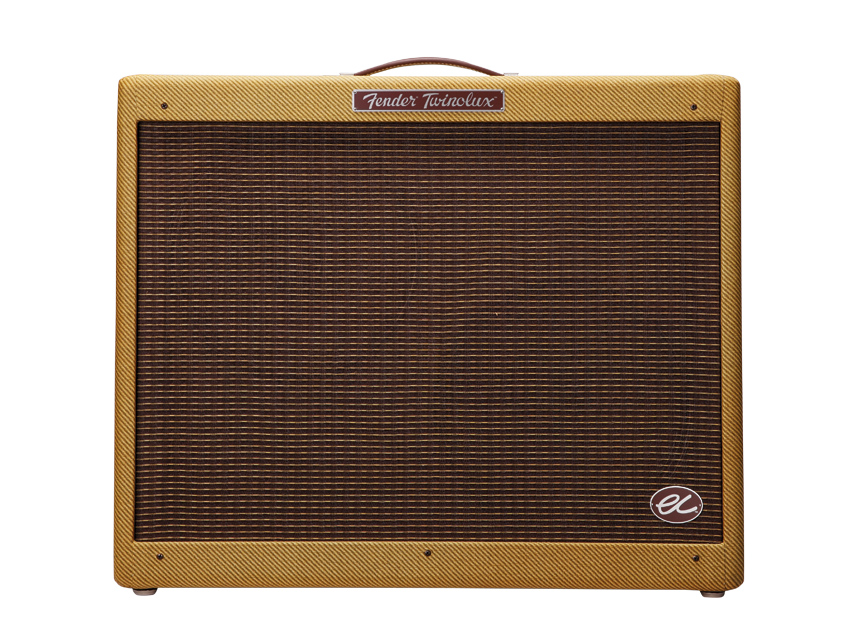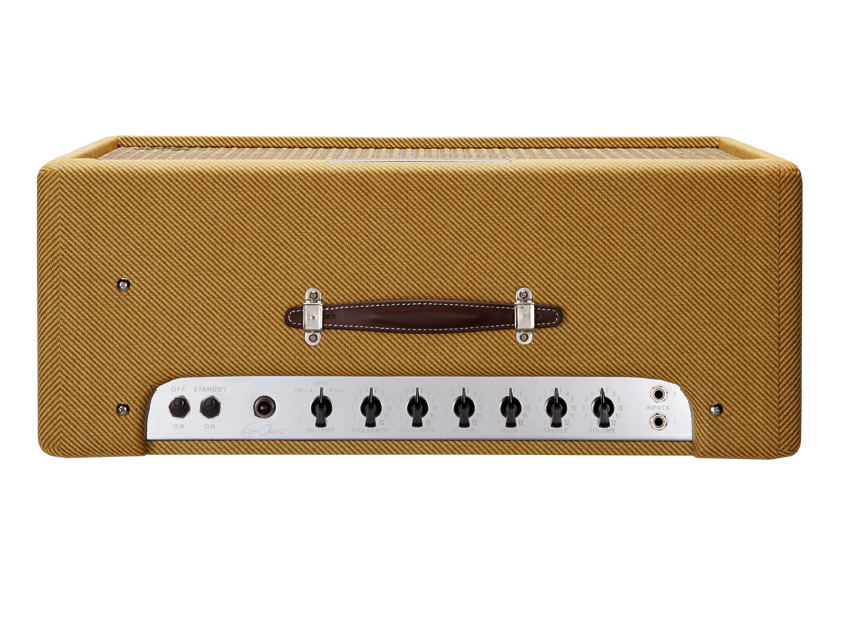MusicRadar Verdict
Mainly for Clapton fans, but if blues is your thing then definitely check them out.
Pros
- +
Authentic 'Tweed' tone; a killer small blues amp for recording and an awesome blues combo for live gigs; oh, and Eric Clapton uses them!
Cons
- -
Pricey compared to like-for-like competition; not very flexible.
MusicRadar's got your back

Fender EC Series Twinolux 2 x 12

Fender EC Series Twinolux 2 x 12

Fender EC Series Twinolux 2 x 12
Practically every amp and guitar manufacturer has at least one artist signature model in their catalogue these days; it's a tried and tested aid to selling the products. However, it wasn't always the case for Fender.
Although there were many artist endorsement campaigns linked to specific instruments, such as the so-called Mary Kaye Stratocaster, there were no artist signature guitars until the arrival of the first Eric Clapton Stratocaster in 1988. Even more surprising, when you remember Fender was building amps long before it built guitars, is that there's never been a Fender artist signature amplifier.
"The dynamic response is the heart of the Twinolux's magic for us. Very few amps can swing between such widely spaced extremes of gain and clarity without the tone suffering somewhere."
Until now, that is. It's fitting and appropriate that the first artist to be honoured with a Fender signature guitar should also be the first to have a Fender signature amplifier to go with it; so this month we're delighted to be looking at two of the new EC Series amplifiers - the Twinolux and Vibro-Champ.
Both amps are inspired by original Fender circuits going back to the famous 'Tweed' era of the 1950s, although they're new designs, created and tweaked to suit Eric's exacting specifications. Outwardly, all the features you'd expect to see on a vintage 'Tweed' amp are present: finger-jointed pine cabinet, brown/gold grille cloth, chrome steel chassis with chickenhead knobs that go to 12 (which is, of course, one more than 11) and a bright red jewel indicator light.
The tweed rear panels are immovable solid timber rather than the bendy hardboard still applied to lesser models. Behind them, the electronics are hand-wired using the traditional Fender eyelet board method.
An eyelet board is a piece of vulcanised fibreboard or other insulating material, with small brass or nickel rivets punched into it to hold wires and component leads. Offering greater freedom for component placing (which can have a dramatic effect in a valve audio circuit), eyelet boards are more popular in the USA, while in the UK and Europe traditional amp building is more often done using turret boards.
Component quality is top class throughout, with heavy-duty transformers and switchgear, connected by extremely neat wiring. The Twinolux is fitted with a pair of special design Alnico speakers made for Fender by Eminence.
Want all the hottest music and gear news, reviews, deals, features and more, direct to your inbox? Sign up here.
It exudes the class and mojo you'd expect from top of the range Custom Shop products, with neatly cut and applied tweed, carefully aligned grille cloths, sharply defined radiuses to the corners and correct period-look fittings. It looks - and is - very expensive, with the capacity to handle endless professional touring.
The Twinolux is loosely based on the original dual rectifier 'Tweed' Twin, with the addition of an attenuator and an old-fashioned bias tremolo circuit. This works by varying the output valve bias current, effectively shutting the valve off and then switching it back on again.
Later tremolo-equipped Fenders used a different arrangement based on an opto-isolator in the signal path - a component that combines a light-dependent resistor with a small bulb or LED. These two traditional types of tremolo sound a little different but neither is 'better': the bias tremolo effect sounds deeper and more organic, but it isn't as quiet and flexible as the opto-isolator type.
We feel that bias tremolo works best on smaller amps - on bigger output stages it will overstress valves causing them to wear out.
The variable output power feature is operated by a three-position switch on the control panel. This gives users the choice of around 40 watts on full power, with a half-power setting and a half-power-with-just-one-speaker option, giving the amp a wide range of headroom and output stage distortion.
In addition to this switch and separate tremolo speed and intensity controls, the Twinolux has high and low gain input jacks, and controls for volume, treble, bass and presence, and there's also a socket for a footswitch to control the tremolo effect. Modern features such as LEDs, master volumes, push-pull switches and effects loops are, as you might expect, totally absent.
Sounds
Nearly half a century down the road, it's worth remembering the profound impact Eric Clapton had on the electric guitar world following his 1966 appearance on the infamous John Mayall 'Beano' album. At that time, two of the most well-known and influential electric guitarists in the UK were Hank B Marvin and Bert Weedon, both great players, but about as far removed from electric blues as possible.
Eric's soaring, fluid pentatonic improvisations, characterised by heavy amp distortion and a singing tremolo, were a turning point in the instrument's development and a milestone in music history. On that single album, Clapton essentially wrote the blueprint for what would become classic rock guitar over the next decade, blazing the trail for just about every other guitar hero who followed him.
During his career, Eric has used all kinds of guitar/amp combinations, but post-Cream it's arguably the Stratocaster teamed with an old 'Tweed' Champ that together have provided some of his most memorable recorded tones and solos.
Listen to the milestone Derek And The Dominos album Layla And Other Assorted Love Songs or the best-selling 461 Ocean Boulevard to hear what we mean. Handed the opportunity of using not only Eric's amps, but also a loaned Clapton Strat, we couldn't help but dig out those classics and try re-creating the sounds on songs such as Layla and Motherless Children, as well as more modern cuts such as Run Back To Your Side from Eric's most recent eponymous album.
As well as the Clapton Strat, we tried the Twinolux out with Fender's superlative Custom Shop Nocaster and a Gibson Les Paul; to achieve maximum headroom it pays to use the low gain input jack and stick to regular single-coils. Plug into the high gain input, turn up to around five or six and the amp really starts to sing, with a powerful but not peaky or nasal mid-range, just a powerful thump of attack at the front of each note that really cuts through a live band mix.
Again, it's a highly responsive circuit with an edgy, mid-range grind that's pure Tweed; players who know how to vary an amp's overdrive by changing pick attack strength or backing off the guitar's volume control will enjoy the Twinolux's uncanny dynamic range; it cleans up better than almost every other amp we've tried.
This dynamic response is the heart of the Twinolux's magic for us. Very few amps can swing between such widely spaced extremes of gain and clarity without the tone suffering somewhere.
The Twinolux is a naturally bright amp. Even with the presence turned off there's a high frequency bite that might be a little too aggressive and edgy for some, especially if you use a bright-toned guitar such as a Telecaster.
The tremolo effect is superb; it pulses with just the right waveform and sounds instantly right for conjuring up that vintage American fifties vibe. Used on full power, the Twinolux's headroom is perfect for smaller gigs while the two low power settings make it easy to dial in for recording or rehearsal.
It's often the case that a signature amp designed to one person's specs can be a bit unforgiving; like its little brother the Vibro-Champ, the Twinolux has some of that - and we're guessing the Tremolux (the mid-sized third combo in the range) does too. However, used for hard-hitting electric blues it sounds superb; there's that edgy Tweed aggression teamed with an organic response that makes it a delight to play, the Clapton Strat just edging it over the Nocaster's awesome bridge pickup as the perfect six-string partner in our test.
Value for money is a tricky subject; aimed primarily at Clapton fans and collectors, this is super-expensive even by Custom Shop standards, although street prices may be more sensible, letting it just make it into the 'okay' value for money marks. Let's not forget, this is a top of the range Custom Shop product and the build quality and tone is definitely right up there where it should be at this level.
For those who seek the full-on Tweed experience but don't need the Clapton kudos, the EC series has stiff competition from both sides of the Atlantic, although none will have two of the biggest names in electric guitar on the cabinet! Ultimately, if using Clapton's rig is your dream, nothing apart from cold hard cash is likely to come between you and owning one of these superb amps.